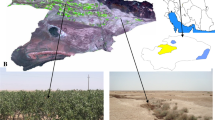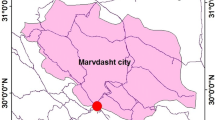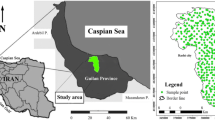Abstract
Accurate estimation of aquifer parameters, especially from crystalline hard rock area, assumes a special significance for management of groundwater resources. The aquifer parameters are usually estimated through pumping tests carried out on water wells. While it may be costly and time consuming for carrying out pumping tests at a number of sites, the application of geophysical methods in combination with hydro-geochemical information proves to be potential and cost effective to estimate aquifer parameters. Here a method to estimate aquifer parameters such as hydraulic conductivity, formation factor, porosity and transmissivity is presented by utilizing electrical conductivity values analysed via hydro-geochemical analysis of existing wells and the respective vertical electrical sounding (VES) points of Sindhudurg district, western Maharashtra, India. Further, prior to interpolating the distribution of aquifer parameters of the study area, variogram modelling was carried out using data driven techniques of kriging, automatic relevance determination based Bayesian neural networks (ARD-BNN) and adaptive neuro-fuzzy neural networks (ANFIS). In total, four variogram model fitting techniques such as spherical, exponential, ARD-BNN and ANFIS were compared. According to the obtained results, the spherical variogram model in interpolating transmissivity, ARD-BNN variogram model in interpolating porosity, exponential variogram model in interpolating aquifer thickness and ANFIS variogram model in interpolating hydraulic conductivity outperformed rest of the variogram models. Accordingly, the accurate aquifer parameters maps of the study area were produced by using the best variogram model. The present results suggest that there are relatively high value of hydraulic conductivity, porosity and transmissivity at Parule, Mogarne, Kudal, and Zarap, which would be useful to characterize the aquifer system over western Maharashtra.










Similar content being viewed by others
References
Archie GE (1942) The electrical resistivity log as an aid in determining some reservoir characteristics, American Institute of Mineral and Metal Engineering. Technical Publication 1422, Petroleum Technology, pp 8–13
Bagtzoglou CA, Hossain F (2009) Radial basis function neural network for hydrologic inversion: an appraisal with classical and spatio-temporal geo-statistical techniques in the context of site characterization. Stoch Environ Res Risk Assess 23:933–945
Bardossy G, Fodor J (2004) Evaluation of uncertainties and risks in geology. Springer-Verlag, Heidelberg
Bishop CM (1995) Neural networks for pattern recognition. Oxford University Press, Oxford
Bobachev C, (2002) IPI2Win: A windows software for an automatic interpretation of resistivity sounding data, Ph.D., Moscow State University
Boerner FD, Schopper JR, Wller A (1996) Evaluation of transport and storage properties in the soil and groundwater zone from induced polarisation measurements. Geophysics 44:583–601
Cassidy R, Comte J, Nitsche J, Wilson C, Flynn R, Ofterdinger U (2014) Combining multi-scale geophysical techniques for robust hydro-structural characterisation in catchments underlain by hard rock in post-glacial region. J Hydrol 517:715–731
Central Ground Water Board (CGWB) (2009) Groundwater information. Sindhudurg district, Maharashtra, p. 16
Chandra S, Ahmed S, Ram A, Dewandel B (2008) Estimation of hard rock aquifers hydraulic conductivity from geoelectrical measurements: a theoretical development with field application. J Hydrol 357:218–227
Chowdhury M, Alouani A, Hossain F (2010) Comparison of ordinary kriging and artificial neural network for spatial mapping of arsenic contamination of groundwater. Stoch Environ Res Risk Assess 24:1–7
Clavier C, Coates G, Dumanoir R (1984) The theoretical and experimental bases for ‘‘dual water’’ model for the interpretation of shaley sands. Soc Pet Eng J 4:153–168
De Lima OAL, Niwas S (2000) Estimation of hydraulic parameters of shaly sandstone aquifers from geological measurements. J Hydrol 235:12–26
Domenico PA, Schwartz FW (1990) Physical and Chemical Hydrogeology. Wiley, New York, p 324
Fetter CW (1994) Applied Hydrogeology, 3rd edn. Prentice-Hall, Inc., New Jersey, p 600
Francis RM (1981) Hydro geological properties of a fractured porous aquifer, Winter River Basin, Prince Edward Island, Unpublished M.Sc. Thesis, University of Waterloo
Frohlich RK, Kelly WE (1985) The relation between hydraulic transmissivity and transverse resistance in a complicated aquifer of glacial outwash deposits. J Hydrol 79(3–4):529–556. doi:10.1016/0022-1694(85)90056-3
Goovaerts P (1999) Impact of the simulation algorithm, magnitude of ergodic fluctuations and number of realizations on the spaces of uncertainty of flow properties. Stoch Environ Res Risk Assess 13:161–182
Heigold PC, Gilkson RH, Cartwright K, Reed PC (1979) Aquifer transmissivity from surficial electrical methods. Groundwater 17:338–345
Hubbard SH, Rubin Y (2002) Hydrogeological parameter estimation using geophysical data: a review of selected techniques. J Contam Hydrol 45:3–34
Huntley D (1986) Relations between permeability and electrical resistivity in granular aquifers. Groundwater 24(4):466–474
Jackson PD, Taylor-Smith D, Stanford PN (1978) Resistivity–porosity-particles shape relationships for marine sands. Geophysics 43:1250–1268
Jang JSR (1993) ANFIS: adaptive network based fuzzy inference system. IEEE Trans Syst Man Cybern 23(3):665–685
Jang CS, Liu CW (2004) Geostatistical analysis and conditional simulation for estimating the spatial variability of hydraulic conductivity in the Choushuj river alluvial fan. Taiwan Hydrol Process 18:1333–1350
Kelly W (1977) Geoelectric sounding for estimating aquifer hydraulic conductivity. Groundwater 15(6):420–425
Khalil MH (2006) Geoelectric resistivity sounding for delineating salt water intrusion in the Abu Zanima area, west Sinai, Egypt. J Geophys Eng 3:243–251
Khan MS, Coulibaly P (2006) Bayesian neural network for rainfallrunoff modeling. Water Resour Res 42:W07409. doi:10.1029/2005WR003971
Koehler KA, Peters T (2013) Influence of analysis methods on interpretation of hazard maps. Ann Occup Hyg 57(5):558–570
Kord M, Moghaddam AA (2014) Spatial analysis of Ardabil plain aquifer potable groundwater using fuzzy logic. J King Saud Univ Sci 26:129–140
Kosinki WK, Kelly WE (1981) Geoelectric soundings for predicting aquifer properties. Groundwater 19:163–171
Kumar D, Rai SN, Thiagaranjan S, Ratna Kumari Y (2014) Evaluation of heterogeneous aquifers in hard rocks from resistivity sounding data in parts of Kalmeshwar taluk of Nagpur district, India. Curr Sci 107(7):1137–1145
Maiti S, Tiwari RK (2010) Neural network modeling and an uncertainty analysis in Bayesian framework: a case study from the KTB borehole site. J Geophys Res 115:B10208. doi:10.1029/2010JB000864
Maiti S, Tiwari RK (2014) A comparative study of artificial neural networks, Bayesian neural networks and adaptive neuro-fuzzy inference system in Groundwater Level Prediction. Environ Earth Sci 71:3147–3160. doi:10.1007/s12665-013-2702-7
Maiti S, Erram VC, Gupta G, Tiwari RK (2012) ANN based inversion of DC resistivity data for groundwater exploration in hard rock terrain of western Maharashtra (India). J Hydrol 464–465:281–293. doi:10.1016/j.jhydrol.2012.07.020
Maiti S, Erram VC, Gupta G, Tiwari RK, Kulkarni UD, Sangpal RR (2013) Assessment of groundwater quality: a fusion of geochemical and geophysical information via Bayesian Neural Networks. Environ Monit Assess 185:3445–3465. doi:10.1007/s10661-012-2802-y
Mantoglou A (2003) Estimation of heterogeneous aquifer parameters from piezometric data using ridge functions and neural networks. Stoch Environ Res Risk Assess 17:339–352
Nabney IT (2004) Netlab algorithms for pattern recognition. Springer, New York
Nayak PC, Sudher KP, Rangan DM, Ramasastri KS (2004) A neuro fuzzy computing technique for modeling hydrological time series. J Hydrol 291:52–66
Neretnieks I, (1985) Transport in fractured rocks. In: Proceedings of the hydrogeology of rocks of low permeability. International Association of Hydrogeologists, Tucson, Arizona, p 306
Niwas S, de Lima OA (2003) Aquifer parameter estimation from surface resistivity data. Groundwater 41(1):94–99
Niwas S, Singhal DC (1981) Estimation of aquifer transmissivity from Dar-Zarrouk parameters in porous media. J Hydrol 50:393–399
Niwas S, Tezkan B, Israil M (2011) Aquifer hydraulic conductivity estimation from surface geoelectrical measurements for Krauthausen Test Site, Germany. Hydrogeol J 19(2):307–315. doi:10.1007/s10040-010-0689-7
Pardo-Iguzquiza E, Chica-Olmo M (2008) Geostatistical simulation when the number of experimental data is small: an alternative paradigm. Stoch Environ Res Risk Assess 22:325–337
Patnode WH, Wyllie MRJ (1950) The presence of conductive solids in reservoir rocks as factor in electric log interpretation. Pet Trans Am Inst Min Metall Pet Eng 189:47–52
Salem HS (1999) Determination of fluid transmissivity and electric transverse resistance for shallow aquifers and deep reservoirs from surface and well-log electric measurements. Hydrol Earth Syst Sci 3(3):421–427
Schwartz WF, Zhang H (2004) Fundamentals of groundwater. Wiley, New York, p 583
Sen PN, Goode PA, Sibbit A (1988) Electrical conduction in clay bearing sandstones at low and high salinities. J Appl Phys 63:4832–4840
Shakeel A, De Marsily G, Alain T (1988) Combined use of hydraulic and electrical properties of an aquifer in a geo statistical estimation of transmissivity. Groundwater 26(1):78–86
Singh KP (2005) Nonlinear estimation of aquifer parameters from surficial resistivity measurements. Hydrol Earth Syst Sci Discuss 2:917–938
Skyernaa L, Jorgensen NO (1993) Detection of local fracture systems by azimuthal resistivity surveys: example from south Norway. In: Memoirs of the 24th Congress of International Association of Hdrogeologists, pp 662–671
Slater LD, Wishart DN, Gates EA (2006) Self potential improves characterization of hydraulically active fracture from azimuthal geoelectrical measurements. Geophys Res Lett 33:L17314
Soupios PM, Kouli M, Vallianatos F, Vafidis A, Stavroulakis G (2007) Estimation of aquifer hydraulic parameters from surficial geophysical methods: a case study of Keritis Basin in Chania(Crete-Greece). J Hydrol 338:122–131
Tutmez B, Hatipoglu Z (2010) Comparing two data driven interpolation methods for modelling nitrate distribution in aquifer. Ecol Inform 5:311–315
Ungemach P, Moslaghini F, Duprat A (1969) Emphasis in determination of transmissivity coefficient and application in nappe alluvial aquifer Rhine. Bull Inst Assoc Sci Hydrol XIV(3):169–190
Vinegar HJ, Waxman MH (1984) Induced polarisation of shaly sands. Geophysics 49(8):1267–1287
Ward SH (1990) Geotechnical and environmental geophysics series: investigations in geophysics, vol 5. Society of Exploration Geophysics, Tulsa
Waxman MH, Smits LJM (1968) Electrical conductivities in oil bearing sands. J Soc Pet Eng 8:107–122
Webster R, Oliver MA (2001) Geostatics for environmental scientists. Wiley, Chichester
Winsauer WO, McCardell WM (1953) Ionic double-layer conductivity in reservoir rock. Trans Am Inst Min Metall Pet Eng 198:129–134
Worthington PF (1977) Geophysical investigation of groundwater resources on the Kalibari Basin. Geophysics 42(4):838–849
Yadav GS, Abolfazli H (1998) Geoelectrical soundings and their relationship to hydraulic parameters in semiarid regions of Jalore, Northwestern India. J Appl Geophys 39:35–51
Yan H, Zou Z, Wang H (2010) Adaptive neuro fuzzy inference system for classification of water quality status. J Environ Sci 22(12):1891–1896
Zhu L, Dai Z, Gong H, Gable C, Teatini P (2016) Statistic inversion of multi-zone transition probability models for aquifer characterization in alluvial fans. Stoch Environ Res Risk Assess 30:1005–1016
Acknowledgments
Authors of respective institute are thankful to their Directors, IIT(ISM), Dhanbad and IIG, New Panvel for their kind permission to publish the work. AD is thankful to IIT(ISM) JRF fellowship in which some analysis work related to her Ph.D. is done. Partial financial benefit from the Ministry of Earth Sciences, Govt. of India, New Delhi, India, is also thankfully acknowledged (Grant No: MoES/P.O. (Geosci)/44/2015). Mr. Uppala Srinu’s help in preparing maps is highly appreciated. We are thankful to the Associate Editor and both the anonymous reviewers for constructive comments which have greatly improved the paper.
Author information
Authors and Affiliations
Corresponding author
Rights and permissions
About this article
Cite this article
Das, A., Maiti, S., Naidu, S. et al. Estimation of spatial variability of aquifer parameters from geophysical methods: a case study of Sindhudurg district, Maharashtra, India. Stoch Environ Res Risk Assess 31, 1709–1726 (2017). https://doi.org/10.1007/s00477-016-1317-4
Published:
Issue Date:
DOI: https://doi.org/10.1007/s00477-016-1317-4




